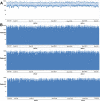Validation and optimization of the Ion Torrent S5 XL sequencer and Oncomine workflow for BRCA1 and BRCA2 genetic testing
- PMID: 28422718
- PMCID: PMC5471017
- DOI: 10.18632/oncotarget.16799
Validation and optimization of the Ion Torrent S5 XL sequencer and Oncomine workflow for BRCA1 and BRCA2 genetic testing
Abstract
In this study, we validated the analytical performance of BRCA1/2 sequencing using Ion Torrent's new bench-top sequencer with amplicon panel with optimized bioinformatics pipelines. Using 43 samples that were previously validated by Illumina's MiSeq platform and/or by Sanger sequencing/multiplex ligation-dependent probe amplification, we amplified the target with the Oncomine™ BRCA Research Assay and sequenced on Ion Torrent S5 XL (Thermo Fisher Scientific, Waltham, MA, USA). We compared two bioinformatics pipelines for optimal processing of S5 XL sequence data: the Torrent Suite with a plug-in Torrent Variant Caller (Thermo Fisher Scientific), and commercial NextGENe software (Softgenetics, State College, PA, USA). All expected 681 single nucleotide variants, 15 small indels, and three copy number variants were correctly called, except one common variant adjacent to a rare variant on the primer-binding site. The sensitivity, specificity, false positive rate, and accuracy for detection of single nucleotide variant and small indels of S5 XL sequencing were 99.85%, 100%, 0%, and 99.99% for the Torrent Variant Caller and 99.85%, 99.99%, 0.14%, and 99.99% for NextGENe, respectively. The reproducibility of variant calling was 100%, and the precision of variant frequency also showed good performance with coefficients of variation between 0.32 and 5.29%. We obtained highly accurate data through uniform and sufficient coverage depth over all target regions and through optimization of the bioinformatics pipeline. We confirmed that our platform is accurate and practical for diagnostic BRCA1/2 testing in a clinical laboratory.
Keywords: BRCA; Ion Torrent; Oncomine; S5 XL; next-generation sequencing.
Conflict of interest statement
The authors declare no conflicts of interest.
Figures



Similar articles
-
Development and Validation of a Next-Generation Sequencing Assay for BRCA1 and BRCA2 Variants for the Clinical Laboratory.PLoS One. 2015 Aug 21;10(8):e0136419. doi: 10.1371/journal.pone.0136419. eCollection 2015. PLoS One. 2015. PMID: 26295337 Free PMC article.
-
Comparison of Ion Personal Genome Machine Platforms for the Detection of Variants in BRCA1 and BRCA2.Cancer Res Treat. 2018 Jan;50(1):255-264. doi: 10.4143/crt.2017.062. Epub 2017 Apr 7. Cancer Res Treat. 2018. PMID: 28392550 Free PMC article.
-
Evaluation of the Ion Torrent PGM sequencing workflow for the routine rapid detection of BRCA1 and BRCA2 germline mutations.Exp Mol Pathol. 2017 Apr;102(2):314-320. doi: 10.1016/j.yexmp.2017.03.001. Epub 2017 Mar 2. Exp Mol Pathol. 2017. PMID: 28263838
-
Hereditary Breast and Ovarian Cancer Syndrome: Moving Beyond BRCA1 and BRCA2.Adv Anat Pathol. 2018 Mar;25(2):85-95. doi: 10.1097/PAP.0000000000000177. Adv Anat Pathol. 2018. PMID: 28914618 Review.
-
MiSeq: A Next Generation Sequencing Platform for Genomic Analysis.Methods Mol Biol. 2018;1706:223-232. doi: 10.1007/978-1-4939-7471-9_12. Methods Mol Biol. 2018. PMID: 29423801 Review.
Cited by
-
Early change in circulating tumor DNA as a potential predictor of response to chemotherapy in patients with metastatic colorectal cancer.Sci Rep. 2019 Nov 22;9(1):17358. doi: 10.1038/s41598-019-53711-3. Sci Rep. 2019. PMID: 31758080 Free PMC article.
-
Bioinformatics analysis of the prognostic value of CCT6A and associated signalling pathways in breast cancer.Mol Med Rep. 2019 May;19(5):4344-4352. doi: 10.3892/mmr.2019.10100. Epub 2019 Mar 28. Mol Med Rep. 2019. PMID: 30942452 Free PMC article.
-
Profiling cancer-associated genetic alterations and molecular classification of cancer in Korean gastric cancer patients.Oncotarget. 2017 Jul 22;8(41):69888-69905. doi: 10.18632/oncotarget.19435. eCollection 2017 Sep 19. Oncotarget. 2017. PMID: 29050249 Free PMC article.
-
Characterization of a novel variant in the HR1 domain of MFN2 in a patient with ataxia, optic atrophy and sensorineural hearing loss.F1000Res. 2022 Sep 2;10:606. doi: 10.12688/f1000research.53230.2. eCollection 2021. F1000Res. 2022. PMID: 38274408 Free PMC article.
-
Correlation between circulating tumor DNA and carcinoembryonic antigen levels in patients with metastatic colorectal cancer.Cancer Med. 2021 Dec;10(24):8820-8828. doi: 10.1002/cam4.4384. Epub 2021 Nov 24. Cancer Med. 2021. PMID: 34821068 Free PMC article.
References
-
- Aziz N, Zhao Q, Bry L, Driscoll DK, Funke B, Gibson JS, Grody WW, Hegde MR, Hoeltge GA, Leonard DG, Merker JD, Nagarajan R, Palicki LA, et al. College of American Pathologists’ laboratory standards for next-generation sequencing clinical tests. Arch Pathol Lab Med. 2015;139:481–493. - PubMed
Publication types
MeSH terms
Substances
LinkOut - more resources
Full Text Sources
Other Literature Sources
Medical
Miscellaneous

